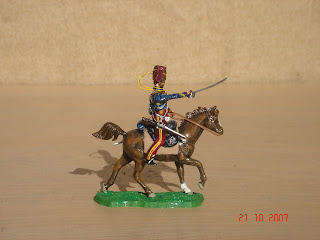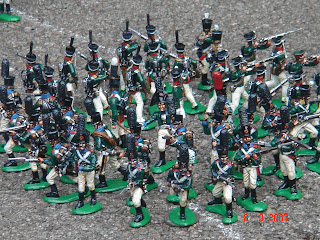




This time we will look at the Crimean War, one of my favourite periods. It is some yardstick on the nature and extent of my insanity that I embark on toy soldier projects that require almost every figure to be drastically converted, and this one is no exception. Shares in greenstuff must have rocketed during this time as I was buying packet after packet, and going through knife blades at a rate of knots.
I think then contrast between the British and Russian uniforms is another reason why this war is so interesting, the British are dressed in classic toy soldier style, whilst their opponents are drab and almost modern looking, I'll publish some Russian photos next time.
So to the pictures, first off an 11th Hussar trooper, one of Lord Cardigan's "Cherry Bums". This is an extremely minor conversion of a standard HELMET Napoleonic British hussar, all I did was add a small cap pouch to his waist belt, made from a scrap of plastic, the water canteen and haversack moulding is another addition. You can see this more clearly in the second photo, which shows our bold hussar alongside a Light Brigade colleague, this time from the 17th Lancers - this is a standard HELMET kit.
Next we have some Scots Greys from the Heavy Brigade. These are mostly old Cherilea heads on CTS Mexican cavalry bodies, mounted on Imex horses, the belts and other equipment are built up from greenstuff. The officer's head is from Timpo, with a somewhat alarming set of whiskers "greenstuffed" to his face.The trumpeter behind him is from the slightly disappointing Italeri Greys set, with built up headgear and trumpet slung across his back from a HELMET spare. Wherever practical I replace plastic swords with metal pins, thickened up gradually with layers of paint, this prevents the plastic blades bending and cracking their paint. I paint in batches, so the left over paint from batch one produces the sword blades for batch 2.
My grandfather was in the Coldstream Guards, so there is a dreadful inevitability about their appearance in my Crimean British army. So the next picture shows a part of the single company I have produced so far. These fellows are from Imex, CTS, Accurate, A Call to Arms, Armies in Plastic and (probably) others, They have heads looted from Britains Deetail figures picked out from rummage boxes at various shows. Plumes, large white epaulets, equipment and cuff flaps from the omnipresent greenstuff with coat fronts trimmed to look double-breasted, buttons have been built up with paint as per the sword blade method outlined above. Finally we have four Highlanders from the Thin Red Streak, the 93rd. These are from Timpo with bonnets, sporrans and cuff flaps from greenstuff. These were quite simple to convert, but maddening to paint, personally I find the tartan not too bad, it's the damn dicing on the headwear and the pattern on the hose that I drives me to distraction, which all goes to explain why there are only four!
I'm still working on War of 1812 American regulars, so an update on progress there, next time. Also some Crimean Russians, and how about some English Civil War to add a bit of contrast?
Any comments or feedback welcomed, and by the way we have added a link to the Blog from the website under the "Latest News" tab.
Many thanks
Eric







